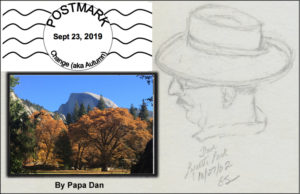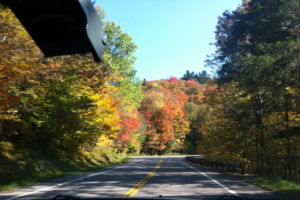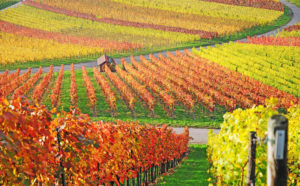Reflections On Change — It’s Fall, Right?

“One cannot make the words too strong.”
— Mark Twain
Click here to download a PDF of this post: Its_Fall_Change
It’s Autumn (aka Fall)
This year, Autumn begins on Monday, September 23 and ends on Saturday, December 21, here in the Northern Hemisphere. During this season, daylight hours become noticeably shorter and the temperature cools considerably. It is also the time when crops and fruits become ready for harvest. In English jargon, over time it has come to be known as The Fall because most leaves fall to the ground and change the color and texture of the landscape dramatically. As a result, all of this change provides great beauty to see in the Fall; and each region has its own style.
Vermont through a windshield—Fall 2013
 Now, some people will tell you that you must travel to New England to see “Real Fall Colors.” OK, Gretta and I did that in the Fall of 2013 just to see the colors and — OK — they do know how to do colors in the northeast when Summer turns to Fall. Vermont, New Hampshire, Connecticut, even Maine, did strut some colorful stuff. BUT, while that experience was spectacular, I’m here to tell you (among other things) that you don’t have to travel to the Northeast to see “Real Fall Colors.” Let’s not forget that we live in California.
Now, some people will tell you that you must travel to New England to see “Real Fall Colors.” OK, Gretta and I did that in the Fall of 2013 just to see the colors and — OK — they do know how to do colors in the northeast when Summer turns to Fall. Vermont, New Hampshire, Connecticut, even Maine, did strut some colorful stuff. BUT, while that experience was spectacular, I’m here to tell you (among other things) that you don’t have to travel to the Northeast to see “Real Fall Colors.” Let’s not forget that we live in California.
So, whadda We got?:
— In southern California, the most notorious source of “Fall colors” is the Black Oak, which turns its leaves to a nice golden yellow.
— In northern California, right here in the Bay Area, big-leaf Maple trees are famous for showing off their gigantic deeply reddened leaves before they fall to the ground.
— Farther north in Humboldt County, we see Oregon Ash, Dogwood, Red Alder, White Alder, Cottonwood, and (watch out!) Poison Oak. Each of these is spectacular and, when you can see them all at once … Whoa! … there are no words …
— In Shasta County, especially around Burney Falls, you can see ALL of those plus Vine Maple, Buck Brush, Deer Brush, Red Flowering Currant, and Squaw Bush — all turning from various shades of green to a profusion of reddish, orangish, yellowish, and brownish hues.
— AND THEN there’s the wine country(ies) throughout California, … as the grapes sweeten for harvest and prepare themselves to become the best wine in the world, the vines and ground cover can fill your eyes with multiple shades of greens and reds and even blues and yellows … well … OK, so you’re going to tell me that it doesn’t make sense to try to describe the dramatic changes that happen in the Fall with words, and you’ll be right. AND THEN, you’ll tell me that showing just one picture, or even two, as examples of this phenomenon will fall miserably short of the task. Below — First: Fall Colors in a California Vineyard — Second: And Up Close.
But, well, you gotta look at some colors before we talk about this subject some more.


So, before we continue, you may ask, what exactly is the subject? Is it really about the colors? Or is it about the only constant we can be sure of in this world — change.
Change Is Gonna Come — Oh, Yes It Will
Of course, all of these magnificent colors appear and the leaves fall to the ground because they are dying. Dying. You know, the living things that grow out of the Earth bud and blossom in the spring, they live their lives all summer, and then they die in the Fall. They must die because the trees and vines must shed their growth, spend the Winter in a comatose state — also known as hibernation, suspended animation, … uh … you know, “death” — so they can be reborn and come back to life in the Spring. But, we have to rake up the dead leaves first — And make no mistake, they are dead. Those are the rules.
It’s about change. It’s about change that must happen. But you knew that …
So, We Look to the Poets
Our poets go out of their way to move us past the obvious and convey to us more than the appearance of stunning changes like those we experience in the Fall; they are inspired by the cool fresh air and the end of oppressive inland heat; they celebrate the wonderful produce of all of that struggle (especially in wine country); AND, they also spend some effort marveling at the “terrible beauty” of the cycle itself — birth to life, life to achievement, achievement to beauty, beauty to death, and death to rebirth. Each of these steps must follow from the steps before them. So, often, poets are trying to reveal how all of this inevitable change feels for us humans and what expectations those feelings generate. So, how do we humans experience change?
Let’s ask some of our poets about change, through eyes that view the colors of the season:
- In this one, a young Shakespeare seems to focus on the sense of loss that Fall brings.
That time of year thou mayst in me behold — Sonnet #73 by William Shakespeare
That time of year thou mayst in me behold
When yellow leaves, or none, or few, do hang
Upon those boughs which shake against the cold,
Bare ruined choirs, where late the sweet birds sang.
In me thou see’st the twilight of such day
As after sunset fadeth in the west;
Which by and by black night doth take away,
Death’s second self, that seals up all in rest.
In me thou see’st the glowing of such fire,
That on the ashes of his youth doth lie,
As the death-bed, whereon it must expire,
Consumed with that which it was nourish’d by.
This thou perceiv’st, which makes thy love more strong,
To love that well, which thou must leave ere long.
- Next, Robert Frost appreciates the colors of the season, but laments the loss that follows.
Nothing Gold Can Stay by Robert Frost
Nature’s first green is gold,
Her hardest hue to hold.
Her early leaf’s a flower;
But only so an hour.
Then leaf subsides to leaf.
So Eden sank to grief,
So dawn goes down to day.
Nothing gold can stay.
- In her book Time and Place, local poet Lauren de Vore reflects on the responsibility for introspection that comes with the expectation of change. In the chapter on Autumn, her sonnet Taking Stock identifies the change of Autumn as something much more than colors.
Taking Stock by Lauren de Vore
October is my time to introspect,
As like a gleaner following the scythe
I cull through recollection’s field and, eyes
Attuned to see, unflinchingly reflect.
It’s easy to tot up the obvious,
That never-ending list of tasks that should
Be done before the rains arrive and would
Were I, in this, not kin to Sisyphus
Th’intangibles are harder to appraise;
Did I come through for those who needed me?
Did kindness guide my words and honesty
My acts, or did I tread a selfish maze?
One must at times take candid look within
In striving for a life that’s genuine.
- Frank DeRose comes right out and tells us that Autumn is gonna bring important change that will matter very much to us humans, well beyond the colors we see around us.
To Change Autumn is the Season by Frank DeRose
Colors turn,
Leaves fall.
For everything there is a time.
Autumn is a time for change,
A time for being human,
A time to reflect
(On warm summer nights),
And a time to anticipate
(Fiery winter days).
We are human.
Ever-changing,
Ever-moving,
Endlessly.
We are autumnal beings.
Yellow with happiness,
Orange with warmth,
And red with anger.
Red with love.
Red with hatred.
We are as cool
As the crisp breeze,
And as warm
As the colors around us.
To everything there is a season,
For everything there is a time.
A time to lie complacent,
And a time for change.
Autumn is the time for change.
- And our dear old friend Mark Twain brings this Autumnal experience to a close by showing us, entirely with his words, the natural climax of the change at the end of Autumn — words that convey this miracle in ways that a photograph could never do. He shows us the New England ice storm that brings the Fall to its dramatic conclusion. In front of an audience one day, Mr. Twain, rambled on like this (it is my favorite paragraph in all American literature):
— If we hadn’t our bewitching autumn foliage, we should still have to credit the weather with one feature which compensates for all its bullying vagaries — the ice-storm: when a leafless tree is clothed with ice from bottom to top — ice that is as bright and clear as crystal; when every bough and twig is strung with ice-beads, frozen dew-drops, and the whole tree sparkles cold and white, like the Shah of Persia’s diamond plume. Then the wind waves the branches and the sun comes out and turns all those myriads of beads and drops to prisms that glow and burn and flash with all manner of colored fires, which change and change again with inconceivable rapidity from blue to red, from red to green, and green to gold — the tree becomes a spraying fountain, a very explosion of dazzling jewels; and it stands there the acme, the climax, the supremest possibility in art or nature, of bewildering, intoxicating, intolerable magnificence.
One cannot make the words too strong. — Mark Twain
So much for the changes that Fall brings. Along with all of these features, the coming of Fall can remind us humans, at least subconsciously, of the other kinds of change we come to expect — if we are optimists — or the kinds of change that we want to see, that we hope for, that we desperately need to see, that we may fear are out of our reach, as we look around at the disappointing world of the time in which we live.
- Among our poets, songwriters have expressed some of our deepest feelings. Speaking for many of his time (late 1964) and of our own who have grown up in hard times, San Cooke wrote a song that never quite made it to the top of the charts, but still insisted on optimism:
A Change Is Gonna Come by Sam Cooke
I was born by the river in a little tent
Oh and just like the river I’ve been running ev’r since
It’s been a long time, a long time coming
But I know a change gonna come, oh yes it will
It’s been too hard living, but I’m afraid to die
‘Cause I don’t know what’s up there, beyond the sky
It’s been a long, a long time coming
But I know a change gonna come, oh yes it will
I go to the movie and I go downtown
Somebody keep tellin’ me don’t hang around
It’s been a long, a long time coming
But I know a change gonna come, oh yes it will
Then I go to my brother
And I say brother help me please
But he winds up knockin’ me
Back down on my knees, oh
There have been times that I thought I couldn’t last for long
But now I think I’m able to carry on
It’s been a long, a long time coming
But I know a change is gonna come, oh yes it will
Experience Teaches; and We Must Learn
So, those of us who look around and see so much that needs to change, so many who desperately need those changes, and so many obstacles stacked up against those changes — what’s a person to do? It seems increasingly clear that it will not be enough to be an optimist, like Sam Cooke, and rest assured that “Change is gonna come — yes it will.” So, we wonder if there are things that some of us urgently need to be doing to bring the changes that the seasons will not bring on their own? Once again, we are reminded of the words of Edmund Burke:
“All that is necessary for evil to triumph is for good men to do nothing.”
A poet of our own time gave us some further advice: “BE the change you seek,” he said. So, we know from the experience of the Fall that change is inevitable. Nothing stays the same and for very good reasons. Some things must die to make way for other things that must arrive. But must we just wait for it like Sam Cooke? Edmund Burke taught us long ago that is the worst thing we can do, and history has proven him right. We can look around and see that some people are MAKING change happen that is seriously evil while we watch — change that unravels progress we thought we had made. Positive changes we thought would endure in the way humans treat each other are reverting to hatreds we had hoped were diminishing. Opportunities for people to raise their standard of living are receding before our eyes in our country — and we see people in power making that happen by their words and actions. Must we merely wait and watch them do their damage and hope for the best? OR, does the optimism of San Cooke carry responsibilities with it to change the course of change itself?
It happens in nature as well as in human behavior. In a world with a warming climate, the changes that come at the end of Fall will be disastrous — we can see it happening if we are paying attention — the necessary ice melts; the rainfall floods the fields instead of nurturing the crops; the bees required to pollinate everything are dying out; the colors are different.
The hard truth is that we know why those things are happening. We know which industrial human behaviors are causing those changes. Yes, it turns out that actually can control the change. If we just wait and watch, others will control the outcome. Some are actually valuing dollars ahead of human survival. How can we make change happen that we need, instead of allowing others to dictate the destructive changes that we can see coming? There’s work to do. We do need to BE the change we seek.
We’ve learned that we are not likely to be successful acting alone. We’ve been told — it takes a village; it takes unions; it takes a unified political party; it takes a committed nation, it takes partnerships and alliances that cross all kinds of borders. Forces that divide and impede our collective efforts must be recognized for the harm they bring and must be defeated. These are hard words; but they are the lessons we have learned.
So, Fall is the time to take stock of our behavior and take responsibility for the effect we have on the direction of change. We have seen what happens when we do nothing. It is not a mystery. We must help each other survive the Winter and bring on the Spring.
![]()